Ielts Academic Reading Sample 126
Taking Wing
To eke out a full-time living from their honeybees, about half the nation’s 2,000 commercial beekeepers pull up stakes each spring, migrating north to find more flowers for their bees. Besides turning floral nectar into honey, these hardworking insects also pollinate crops for farmers -for a fee. As autumn approaches, the beekeepers pack up their hives and go south, scrambling for pollination contracts in hot spots like California’s fertile Central Valley.
Of the 2,000 commercial beekeepers in the United States about half migrate This pays off in two ways Moving north in the summer and south in the winter lets bees work a longer blooming season, making more honey — money — for their keepers. Second, beekeepers can carry their hives to farmers who need bees to pollinate their crops. Every spring a migratory beekeeper in California may move up to 160 million bees to flowering fields in Minnesota and every winter his family may haul the hives back to California, where farmers will rent the bees to pollinate almond and cherry trees.
Migratory beekeeping is nothing new. The ancient Egyptians moved clay hives, probably on rafts, down the Nile to follow the bloom and nectar flow as it moved toward Cairo. In the 1880s North American beekeepers experimented with the same idea, moving bees on barges along the Mississippi and on waterways in Florida, but their lighter, wooden hives kept falling into the water. Other keepers tried the railroad and horsedrawn wagons, but that didn’t prove practical. Not until the 1920s when cars and trucks became affordable and roads improved, did migratory beekeeping begin to catch on.
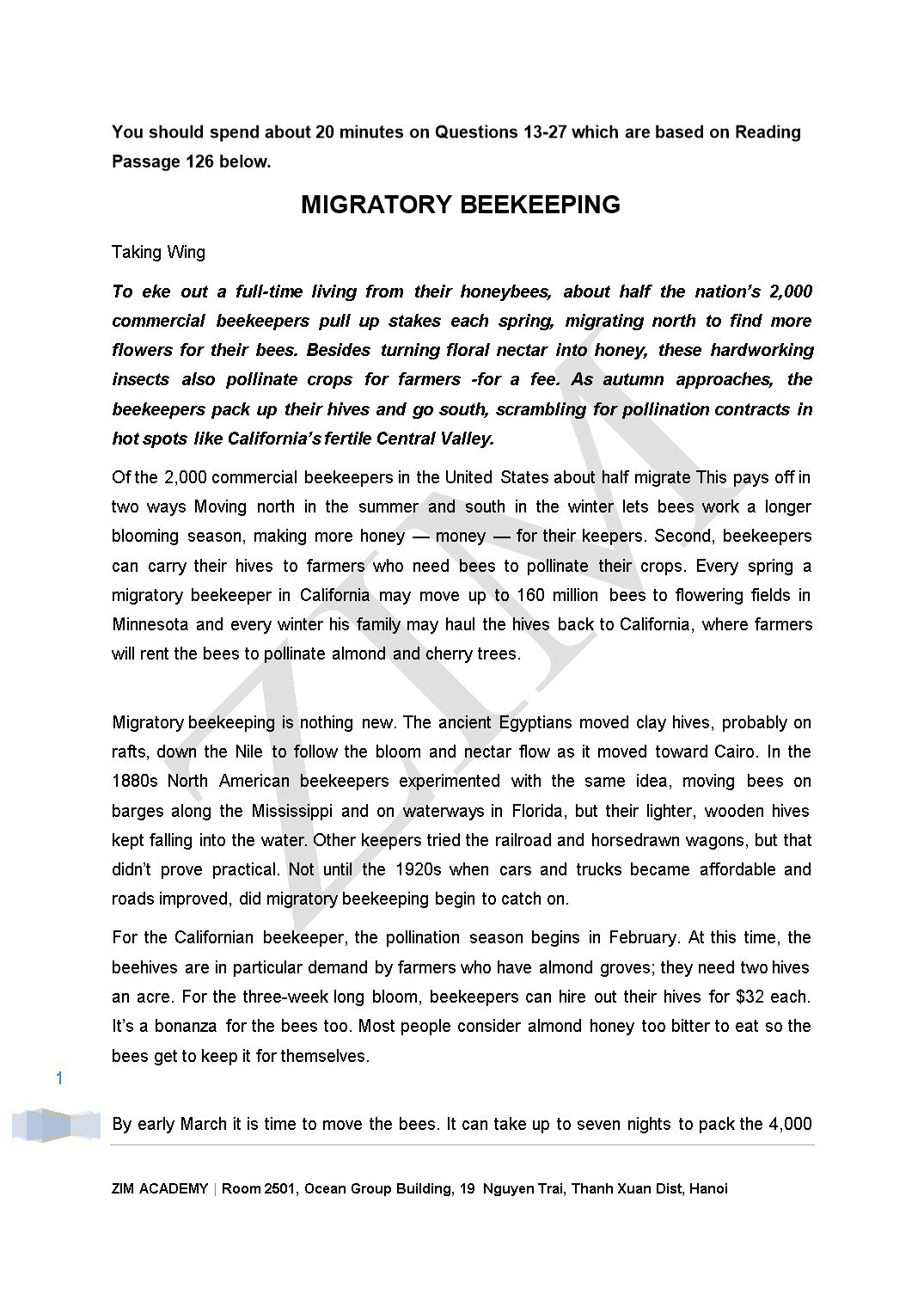
Trang 1
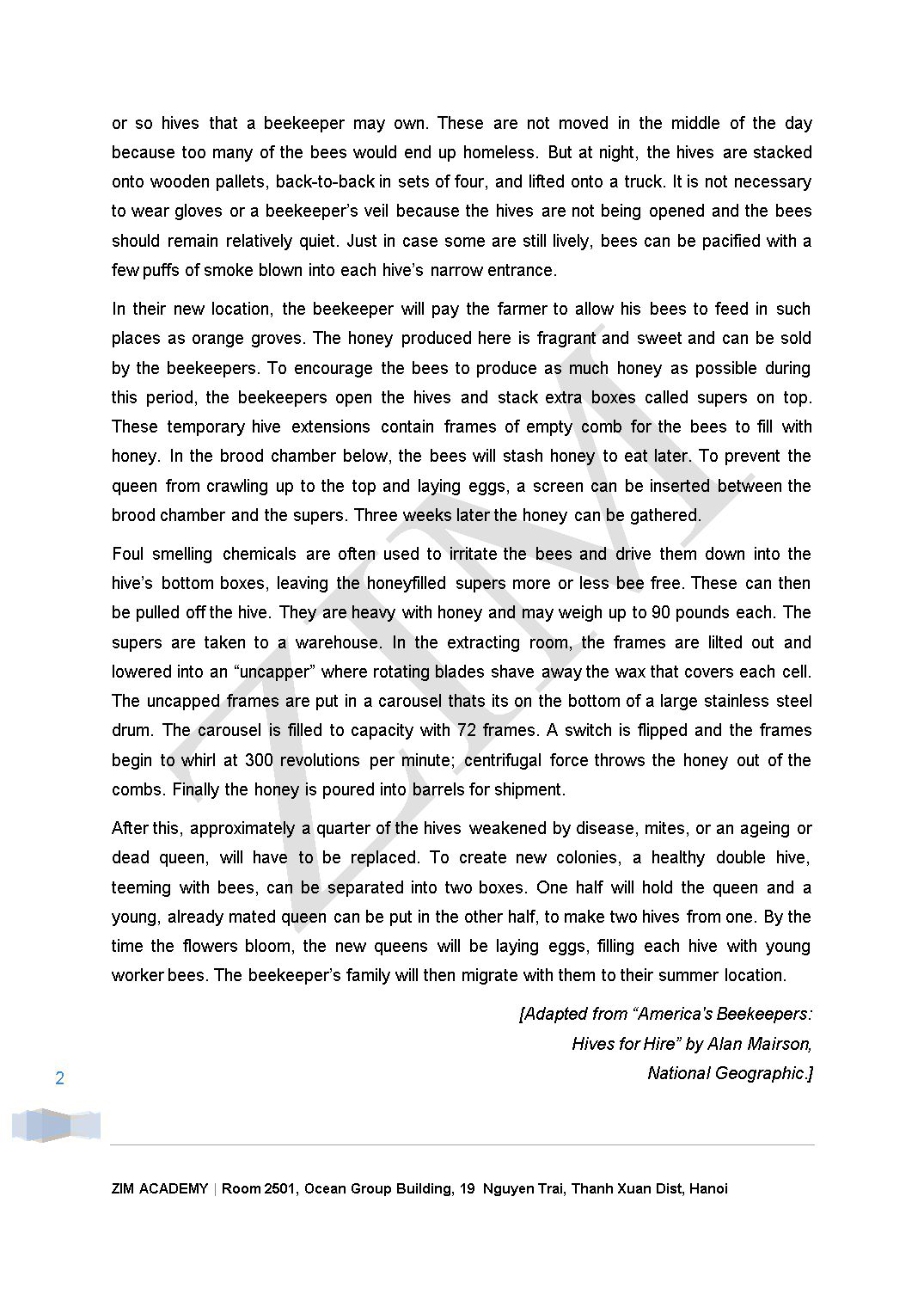
Trang 2
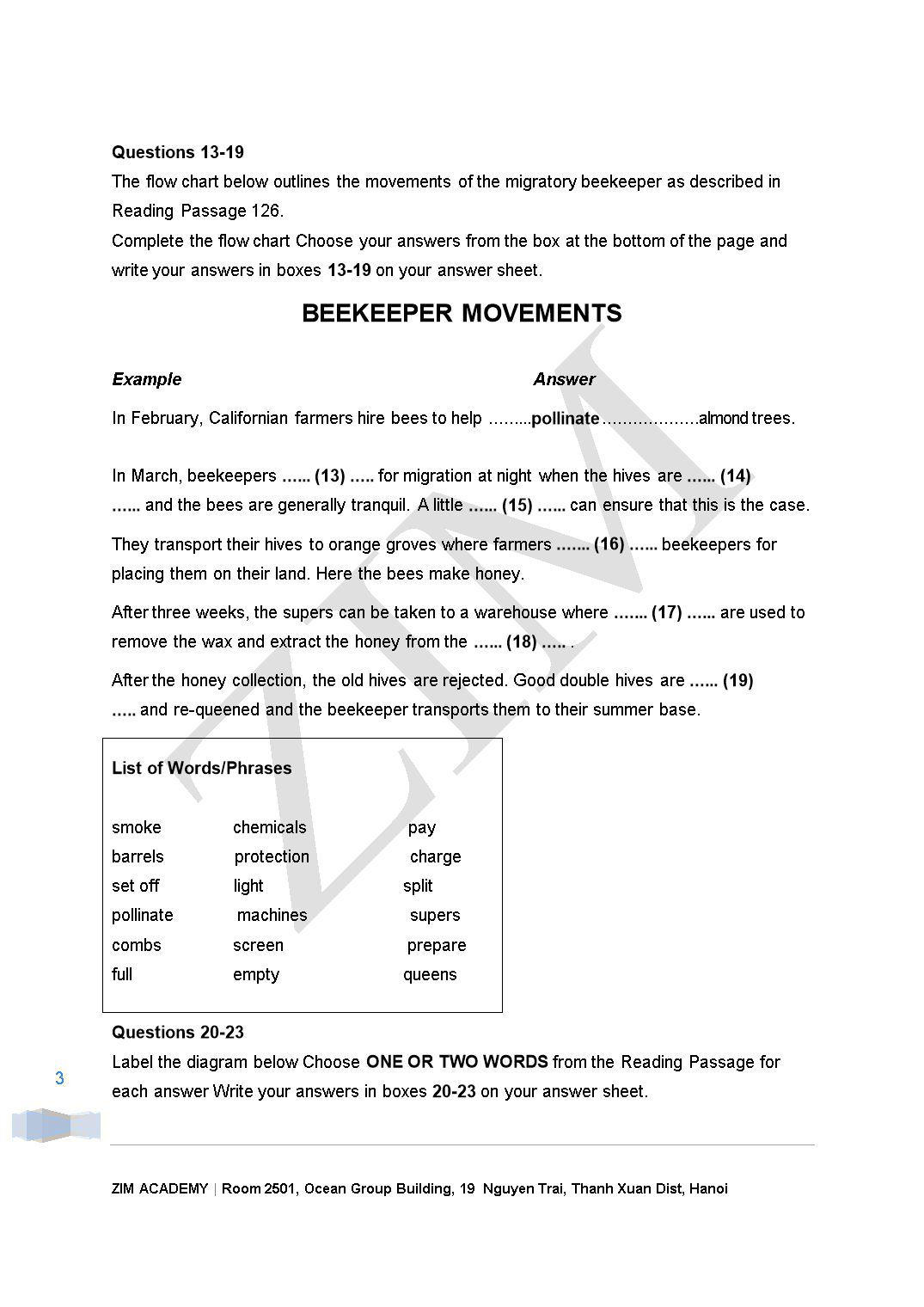
Trang 3
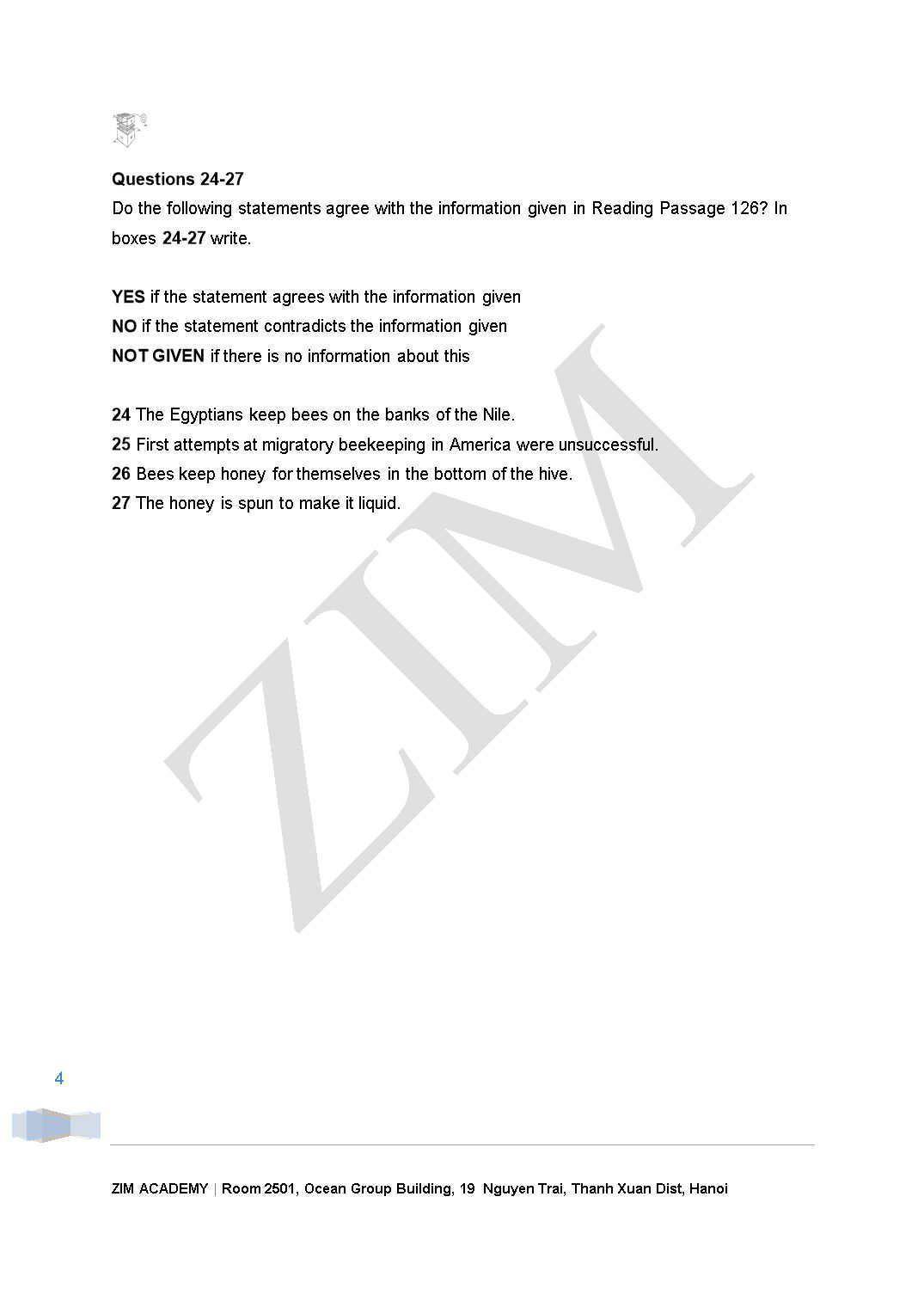
Trang 4
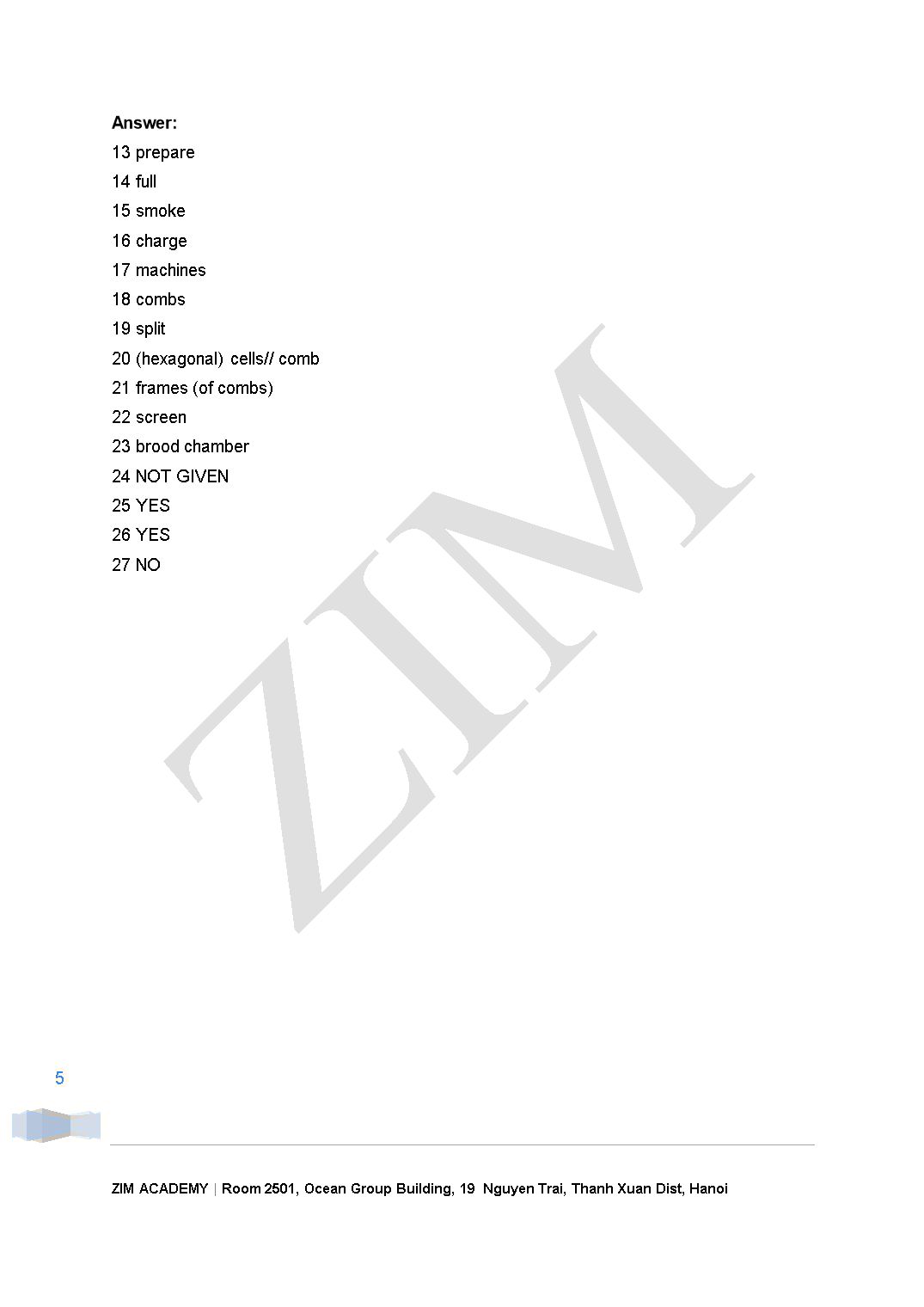
Trang 5
Tóm tắt nội dung tài liệu: Ielts Academic Reading Sample 126
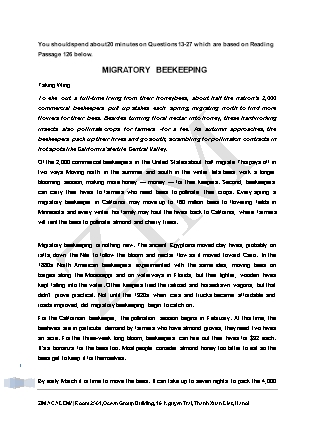
You should spend about 20 minutes on Questions 13-27 which are based on Reading Passage 126 below. MIGRATORY BEEKEEPING Taking Wing To eke out a full-time living from their honeybees, about half the nation’s 2,000 commercial beekeepers pull up stakes each spring, migrating north to find more flowers for their bees. Besides turning floral nectar into honey, these hardworking insects also pollinate crops for farmers -for a fee. As autumn approaches, the beekeepers pack up their hives and go south, scrambling for pollination contracts in hot spots like California’s fertile Central Valley. Of the 2,000 commercial beekeepers in the United States about half migrate This pays off in two ways Moving north in the summer and south in the winter lets bees work a longer blooming season, making more honey — money — for their keepers. Second, beekeepers can carry their hives to farmers who need bees to pollinate their crops. Every spring a migratory beekeeper in California may move up to 160 million bees to flowering fields in Minnesota and every winter his family may haul the hives back to California, where farmers will rent the bees to pollinate almond and cherry trees. Migratory beekeeping is nothing new. The ancient Egyptians moved clay hives, probably on rafts, down the Nile to follow the bloom and nectar flow as it moved toward Cairo. In the 1880s North American beekeepers experimented with the same idea, moving bees on barges along the Mississippi and on waterways in Florida, but their lighter, wooden hives kept falling into the water. Other keepers tried the railroad and horsedrawn wagons, but that didn’t prove practical. Not until the 1920s when cars and trucks became affordable and roads improved, did migratory beekeeping begin to catch on. For the Californian beekeeper, the pollination season begins in February. At this time, the beehives are in particular demand by farmers who have almond groves; they need two hives an acre. For the three-week long bloom, beekeepers can hire out their hives for $32 each. It’s a bonanza for the bees too. Most people consider almond honey too bitter to eat so the bees get to keep it for themselves. By early March it is time to move the bees. It can take up to seven nights to pack the 4,000 or so hives that a beekeeper may own. These are not moved in the middle of the day because too many of the bees would end up homeless. But at night, the hives are stacked onto wooden pallets, back-to-back in sets of four, and lifted onto a truck. It is not necessary to wear gloves or a beekeeper’s veil because the hives are not being opened and the bees should remain relatively quiet. Just in case some are still lively, bees can be pacified with a few puffs of smoke blown into each hive’s narrow entrance. In their new location, the beekeeper will pay the farmer to allow his bees to feed in such places as orange groves. The honey produced here is fragrant and sweet and can be sold by the beekeepers. To encourage the bees to produce as much honey as possible during this period, the beekeepers open the hives and stack extra boxes called supers on top. These temporary hive extensions contain frames of empty comb for the bees to fill with honey. In the brood chamber below, the bees will stash honey to eat later. To prevent the queen from crawling up to the top and laying eggs, a screen can be inserted between the brood chamber and the supers. Three weeks later the honey can be gathered. Foul smelling chemicals are often used to irritate the bees and drive them down into the hive’s bottom boxes, leaving the honeyfilled supers more or less bee free. These can then be pulled off the hive. They are heavy with honey and may weigh up to 90 pounds each. The supers are taken to a warehouse. In the extracting room, the frames are lilted out and lowered into an “uncapper” where rotating blades shave away the wax that covers each cell. The uncapped frames are put in a carousel thats its on the bottom of a large stainless steel drum. The carousel is filled to capacity with 72 frames. A switch is flipped and the frames begin to whirl at 300 revolutions per minute; centrifugal force throws the honey out of the combs. Finally the honey is poured into barrels for shipment. After this, approximately a quarter of the hives weakened by disease, mites, or an ageing or dead queen, will have to be replaced. To create new colonies, a healthy double hive, teeming with bees, can be separated into two boxes. One half will hold the queen and a young, already mated queen can be put in the other half, to make two hives from one. By the time the flowers bloom, the new queens will be laying eggs, filling each hive with young worker bees. The beekeeper’s family will then migrate with them to their summer location. [Adapted from “America's Beekeepers: Hives for Hire” by Alan Mairson, National Geographic.] Questions 13-19 The flow chart below outlines the movements of the migratory beekeeper as described in Reading Passage 126. Complete the flow chart Choose your answers from the box at the bottom of the page and write your answers in boxes 13-19 on your answer sheet. BEEKEEPER MOVEMENTS Example Answer In February, Californian farmers hire bees to help .........pollinate...................almond trees. In March, beekeepers ...... (13) ..... for migration at night when the hives are ...... (14) ...... and the bees are generally tranquil. A little ...... (15) ...... can ensure that this is the case. They transport their hives to orange groves where farmers ....... (16) ...... beekeepers for placing them on their land. Here the bees make honey. After three weeks, the supers can be taken to a warehouse where ....... (17) ...... are used to remove the wax and extract the honey from the ...... (18) ..... . After the honey collection, the old hives are rejected. Good double hives are ...... (19) ..... and re-queened and the beekeeper transports them to their summer base. List of Words/Phrases smoke chemicals pay barrels protection charge set off light split pollinate machines supers combs screen prepare full empty queens Questions 20-23 Label the diagram below Choose ONE OR TWO WORDS from the Reading Passage for each answer Write your answers in boxes 20-23 on your answer sheet. Questions 24-27 Do the following statements agree with the information given in Reading Passage 126? In boxes 24-27 write. YES if the statement agrees with the information given NO if the statement contradicts the information given NOT GIVEN if there is no information about this 24 The Egyptians keep bees on the banks of the Nile. 25 First attempts at migratory beekeeping in America were unsuccessful. 26 Bees keep honey for themselves in the bottom of the hive. 27 The honey is spun to make it liquid. Answer: 13 prepare 14 full 15 smoke 16 charge 17 machines 18 combs 19 split 20 (hexagonal) cells// comb 21 frames (of combs) 22 screen 23 brood chamber 24 NOT GIVEN 25 YES 26 YES 27 NO
File đính kèm:
 ielts_academic_reading_sample_126.doc
ielts_academic_reading_sample_126.doc

